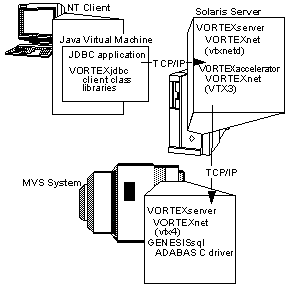Scenario 4
VORTEXjdbc, VORTEXaccelerator on Solaris,
and GENESISsql ADABAS C on MVS

In Scenario 4, a JDBC client application running on Windows connects to
an ADABAS C database server on MVS, using VORTEXaccelerator on Solaris. The
components, URLs, user names and passwords are all examples. You must substitute
the correct values for your own site.
This scenario is very helpful for Web based applications that need to access
legacy databases such as ADABAS C. The VORTEXaccelerator serves as a
connection multiplexer and provides fast connections to the legacy system.
Components
Client
»
VORTEXjdbc
»
connection URL for Drivermanager.getConnection():
jdbc:vortex://scott/tiger@1958:myaccel!/usr2/trifox/bin/vtxhost.mux
Server
»
machine name: myaccel
»
machine operating system: Solaris
»
VORTEXnet
Server (MVS)
»
machine name: myadabas
»
machine operating system: MVS
»
VORTEXnet
»
GENESISsql
Sequence
Before you begin, the VORTEXnet evaluation kit, which includes the daemon and driver,
must be installed
in /usr2/trifox/bin on Solaris and on the MVS system as directed in the
Installation Guide. The VORTEXaccelarator must have been configured on Solaris. This
is a complex procedure that must be completed first.
- The VORTEXdaemon, vtxnetd, is started on myaccel as:
vtxnetd -p1958 &
- When Drivermanager.getConnection() is executed, a message is sent via the socket
(port 1958) to vtxnetd to start up vtxhost.mux. This message registers the client
application with VORTEXaccelerator.
- When the JDBC application attempts its
first SQL operation, the message is sent to VORTEXaccelerator which then
starts up a vtxslav.net. This process then sends a message to VORTEXserver on
MVS to start a connection to GENESISsql.
- GENESISsql then connects to ADABAS C.
vtxslav.net remains connected to GENESISsql until VORTEXaccelerator stops or
the VORTEXaccelerator daemon detects that the connection has been used in the
allocated time and signals vtxslav.net to release.
© 1985-2025
Updated 30 Mar 2010.
|
![[LOGO]](/img/logo.gif)
![[Navigation Map]](/img/combo.gif)
![[LOGO]](/img/logo.gif)
![[Navigation Map]](/img/combo.gif)